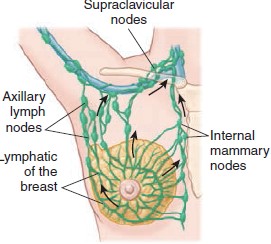Axillary Lymphoedema
Axillary Surgery and Radiation Therapy is a standard practice of breast cancer treatment. The axillary lymph nodes are removed or treated with radiation therapy if cancer has progressed and involved the next level.
During surgery, the lymphatic system pathways are affected resulting in risk of fluid over load leading to lymphedema. Tissues in the distal part of the armpit or axilla such as hand , arm, underarm, chest or upper back can be affected when the lymph fluid builds up and cannot flow back.
Symptoms and Signs of Lymphedema
- Gradual swelling, discomfort and increased warmth of the affected upper limb
- Gradually feels fullness or heaviness of the arm.
- Slight puffiness and tightness of the skin
- Unable to wear or fit watches, rings or bracelets and clothes.
- There is an indentation on the skin when applying pressure
- Redness, inflammation, pain are signs of possible infection

Image showing right upper limb lymphedema
Studies have shown that incidence of lymphedema after breast cancer surgery to the axilla and radiation therapy can range between 10% to 20%.
Risk of lymphedema is also higher in the following conditions:
- When more lymph nodes are removed
- Higher and more radiation given to the armpit
- Obesity and weight gain.

The Axillary Lymphatic System
Breast cancer cells can invade and spread through the lymphatic system and affect the axillary nodes.
When invasive breast cancer is confirmed, axillary node surgery is necessary to determine if the nodes are affected.
Axillary surgery can be offered in 2 ways depending on the stage of the cancer
- Sentinel node biopsy (fewer nodes are removed)
- Axillary lymph node dissection/ clearance (slight more nodes are removed)
References:
Prevention of Lymphoedema
The best way to prevent lymphoedema is education and awareness.
Before Surgery:
Ask if you can be offered Sentinel node biopsy
After Surgery:
Referred to a physiotherapist or lymphoedema therapist who are trained in lymphedema prevention and management. She will counsel you and advice a set of gentle exercise to do
- Immediately after surgery
- 2 weeks after surgery
- 1 month after surgery
- Short and long term care after surgery.
Recommended Guideline for Care and Prevention after Surgery
- Protect and care for your skin
- Avoid excessive overuse, pressure and extreme temperatures of hot and cold of the affected arm.
- Regular visit the lymphedema therapist to assess and advice exercise.
- Do not gain excessive weight
Source:
Lymphoedema treatment
- Best treatment is prevention – by regular gentle exercise and caring for the arm
- Manual lymphatic drainage by trained therapist to encourage lymph flow
- Compression sleeves, bandages and pumps – to help with lymph flow out of the arm
- Lifestyle changes eg skin protection, exercise, and losing weight.
The most common treatment is called Complete Decongestive Therapy (CDT), consists of 4 components:
- Manual lymphatic drainage.
- Skin management
- Wrapping
- Self-treatment
< Back to Breast Cancer Treatment : Surgery
